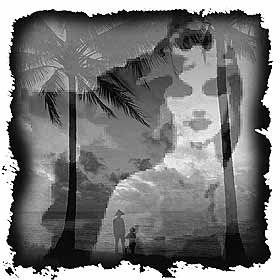The images we have of gorgeous beaches everywhere in the world are similar: rocky cliffs and sand hit regularly by rolling waves under a clear blue sky. On a clear morning or evening, the beaches are a great place to stroll while watching sunrise or set. Not all beaches, however, have a unique tale behind them. One of the few that does is Parangtritis Beach in Yogyakarta, Central Java, Indonesia.
Located about 35 km to the south of Yogyakarta, Parangtritis Beach has long been famous, not only as a beach resort where sand-dunes, sandy beaches and rocky cliffs meet, but also as a historical place closely linked to the mysterious legend of the Queen of the South Sea, "Kanjeng Ratu Kidul". Together with her confidant, the feared Nyai or Nyi Roro Kidul, the ever youthful and beautiful queen, Kanjeng Ratu Kidul reigns over sea-nymphs and spirits.
The legends say that Kanjeng Ratu Kidul was married to one of the Mataram Monarchs, Panembahan Senopati, whom she visited and communed with on certain occasions.
On certain days known as Suro in the Javanese calender, locals have a ceremonial procession, with many seen presenting offerings on the beach in honour of the Nyai Roro Kidul and Queen of the South Sea. During the day, many visit the beach and hold what is known locally as tirakatan (one-day fasting) as they pray for their wishes to be fulfilled. People in black are frequently seen sitting on the beach in a meditating pose the whole night. Locals who have meditated on the beach have said that through meditating they could see a green dragon and Nyi Roro Kidul, who remains young and beautiful. "The dragon danced before my eyes," one local said in a convincing voice. Another admitted that he meditated there so that he could meet the ever-youthful and beautiful Nyi Roro Kidul. "I can even communicate with spirits here," he added.
The legend of Nyi Roro Kidul herself is very popular. Before turning into a nymph, Nyai Roro Kidul was a young princess named Dewi Kandita, the daughter of King Mundangwangi and his first wife. The popularity of Dewi Kandita and her mother Dewi Rembulan was beyond doubt. They were known for their beauty, kindness and friendliness, and people loved them. However, the misery of their lives began when Dewi Mutiara, another wife of King Mundangwangi, known locally as selir, became green with envy and grew ambitions to become the first wife, thereby deserving full affection and attention from the king.
Dewi Mutiara's dream came true when one day she bore the son that the king had long been yearning for. Through the assistance of a witch, Dewi Mutiara made the king's wives Dewi Rembulan and Dewi Kandita suffer from 'strange' disease, with their bodies covered with scabies that created the odour of fish. The disease led them to be sent into exile in the forest where later Dewi Rembulan died. After a long, hard and helpless journey, the scabies-covered Dewi Kandita eventually arrived at a beach where she met a young, handsome man who promised to cure her illness. At the request of the young man, Dewi Kandita chased after him as he ran along the beach. When she reached the water, the man disappeared and, to her surprise, all the scabies had disappeared but, strangely, she could not move her legs. Half her body, from the waist down, had turned into the body of a fish.
Since then she became a sea-nymph, and the locals believe that Nyi Roro Kidul is the manifestation of Dewi Kandita. Want to see Nyi Roro Ridul? Then try meditating the whole night there as locals have suggested.
| 















